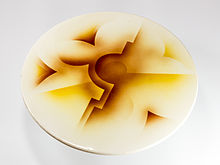Earthenware factory Paetsch
The earthenware factory Paetsch was an important and recognized German manufacturer of earthenware at home and abroad, based in Frankfurt (Oder) .
history
With a publication in the Frankfurter Patriotisches Wochenblatt on November 5, 1840, Die Steinut-Fabrik WE Paetsch founded his stoneware factory in the north of Frankfurt (Oder) with the recommendation to sell dishes at cheap factory prices . In 1846, Joh. Adam Hintze and the businessman Wilhelm Eduard Paetsch appeared in the address book of the city of Frankfurt (Oder) as owners. From 1863 the partnership changed to Georg Theodor Paetsch and Wilhelm Gust. Leop. Selle, the company now only ran under the Paetsch stoneware factory . In 1890, after the death of Georg Theodor, his son Theodor and his brother Walter took over, from 1930 to 1945 Theodor Paetsch junior. and from 1953 Irmgard Paetsch took over the management.
The stoneware factory was located in the industrial district directly on the Oder . This enabled raw materials and fuel to be shipped directly by water . With a siding, the goods could be loaded into wagons to the freight station and transported from there via the Lower Silesian-Märkische Railway . With the favorable location conditions, the extensive expansion of the factory area followed.
The product range initially included kitchenware such as storage vessels, milk pots and jugs. The range was aimed at inexpensive folk crockery with a high availability guarantee. In order to be able to guarantee this inexpensive series production , it was assumed during the shaping process that one type of shape would be used for different vessels. The decors, such as squares, spikes, angles and stripes, were applied by spraying and using stencils in mostly bright colors. The standard shapes were retained for many years, making it possible to produce replacement parts in the long term. Furthermore, smaller series of one-off pieces were produced, the price of which stood out from simple folk crockery thanks to their decor and gold decoration . In addition to fruit plates with colored fruit still lifes, this also included asparagus platters , the edges of which were decorated with gold - tipped asparagus tips.
The stoneware factory was granted a privilege in the production of large washing sets, since the production in porcelain was not economical. So sanitary technology was now also part of the product range. With this range of goods, the Paetsch company created a large sales market at home and abroad at the end of the 19th century. The first export deals were concluded from 1899. For example to India , Mexico and Zanzibar . As one of the first stoneware manufacturers, the Paetsch company used the innovation of decorating stoneware with silver and colored grounds.
The stoneware factory presented presentations from 1920 to 1942 at the Leipziger Messe in the Mädlerpassage . The magazine Die Schaulade Deutscher Wert- und Kunstarbeit regularly presented the latest collections from the Paetsch factory.
In 1933 the design and decoration changed. Ornaments from the plant world and rural motifs, some of which were hand-painted, now adorned the dishes. All items received spongy edges based on the examples of Silesian ceramics.
The price regulation set by the German earthenware industry in 1933 brought the Paetsch company the best possible sales. Due to the war economy with the beginning of the Second World War , only a few products were added to the tableware range, such as a tea warmer with ivory glaze and interior red painting and the corresponding teapot.
In 1945, at the end of the Second World War , 75% of the factory site, which had grown to over 10,000 m², was destroyed. Reconstruction began on May 21, 1945. In 1947 the company again took part in the Leipzig Trade Fair. There was great demand from buyers for tableware. But since the provincial government had not released a trade fair contingent for earthenware, only a few orders were concluded in interzonal trade . The sale with foreign partners took place through preliminary negotiations requiring approval, as the prices were set by the government through the Soviet military administration in Germany .
In 1953 it was nationalized and the factory was now run under the name VEB (K) Steingutfabrik Frankfurt (Oder). The product range was expanded to include decorative bowls and flower pots. After a brief change in production to drainage pipes, the factory was closed in 1955.
Since September 8, 2011, the Viadrina Museum has been exhibiting coveted collector's items.
Individual evidence
- ↑ Frauke Adesiyan: Cultural history on cake plates . In: Märkische Oderzeitung . Frankfurt (Oder) September 6, 2011 ( moz.de [accessed April 14, 2017]).
- 1995 yearbook of the city of Frankfurt (Oder)

